
| Jacket 36 — Late 2008 | Jacket 36 Contents page | Jacket Homepage | Search Jacket |
The Internet address of this page is http://jacketmagazine.com/36/r-jones-omara-rb-lorange.shtml
Patrick Jones and Peter O’Mara
How To Do Words With Things
reviewed by Astrid Lorange
136 pp. Tree-Elbow Publishing. Paper. $29.95. 978—0-9580307—4-8 Distributed by Books[ât]Manic, http://www.manic.com.au/
This review is about 11 printed pages long. It is copyright © Astrid Lorange and Jacket magazine 2008.See our [»»] Copyright notice.
1
How to Do Words With Things is a beautiful book object. The front cover is the back cover, and the back the front: each a beginning and an end. The two works that comprise the one object–A Free-Dragging Manifesto by Patrick Jones and subtext by Peter O’Mara–face each other in a reverse doubling, like the opening and closing punctuation of quotation marks, or the snug in-folding of two kippers, top-to-tail in a can. The book is made from the chlorine-free pulp of sustainable plantation trees and is printed using vegetable oil-based inks. It is, as Jones said in an email exchange, “practically edible!”
2
Jones notes in his Manifesto that one of the catalysts for this book was How to Do Words With Things, a collection of poems published in 1998 by Joan Retallack. Retallack, a poet and critic from New York, experiments in the lively crossovers of philosophy, science and language theory. Her work is concerned with ‘complex realism,’ a poetical play-space in which the dynamics of indeterminacy, change and chaos are embraced as compositional potentials. For Retallack, an experimental poetics that is sensitively engaged with the mutability of the present and the chanciness of chaotic systems is a poetics connected to the world, in and of the world.
paragraph 3
Retallack’s How to Do Things With Words shares its name with a collection of essays by JL Austin, originally presented as a lecture series at Harvard in 1955. Retallack ‘takes up’, in a sense, Austin’s notion of the speech-act and moves the discussion of utterance into muddy zones of simultaneity, collision and confusion. Connections between Austin, Retallack and Jones/O’Mara suggest a contemporary tradition of experimentalism that is explicitly interested in the material and performative qualities of language.

4
How to Do Words With Things is a significant contribution to this tradition and opens up conversations about the future of experimental poetics in Australia. In each of the two halves of this book, Jones and O’Mara raise serious, high-stake questions about our contemporary moment. Both work specifically with the languages of chaos: from the well-worded exploitations of consumer-capitalism to the anarchic harmony of the chance-generated “slow text” and “incidental hypotheses”.
5
Ten years on from the book of poetry which inspired Jones and O’Mara, Retallack is still interested in the possibilities of contemporary poetry, and the impact such poetry might have on the social, cultural and political matrices of the present. In a recent conference paper, she claimed that “interrogatively experimental, ecopoetic [and] agonistically procedural” poetry “may be necessary to underscore the urgent relevance of poetry to society in our times.” Retallack calls on a contemporary poetics that works explicitly in the charged synergy of “reciprocal alterity,” an experimental model concerned with possibilities of meaning-full relations. How to Do Words With Things is all of these things.
¶
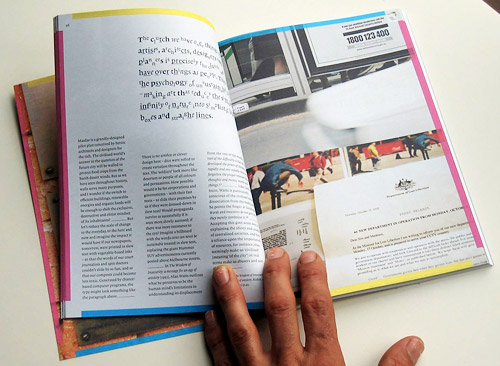
6
In Jones’s half of the book, the Free-dragging Manifesto is prefaced by a series of short essays that background the poetical, material and philosophical properties of his “low-end cultural practice” (38). The essays provide a context for Jones–artist, poet, thinker, organic gardener, composter, father–and his work. Intimately engaged in his everyday life, Jones focuses on the need to be aware, to “see critically” (6) and to interrogate the nature of his local and global environments. “Once you can find surprise in intimate and everyday things,” says Jones, “the spectacle of consumer culture–the dominant hegemony–is revealed as dull and vacuous, dualistic and turgid” (6). For Jones, a commitment against the dominance of consumer capitalism is a commitment to art-making that is “unheroic, simple, gestural, philosophical, non-exploitative, humorous and tending towards the loose” (5).
7
Jones describes his artworks as “poetical terrorism” or “physical graffiti” (38), a practice of site-specific, improvised and/or indeterminate happenings that disrupt public space, creating “temporary autonomous zones” (40). An example is Jones’s ongoing campaign against the Coca-Cola-owned bottled water, Mt Franklin, which is sourced (at a steal) from Jones’s local area in Victoria, bottled and branded as a consumer commodity and then sold for a massive profit.
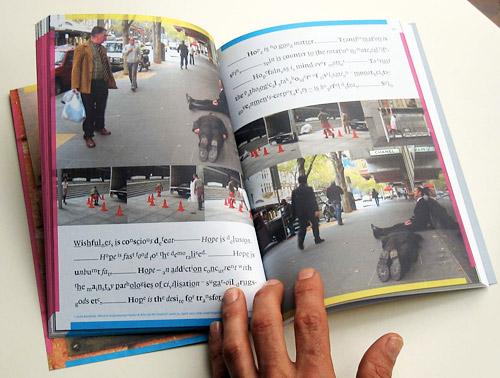
8
Jones has written extensively about the production of Mt Franklin water, and his essay Lalgambook (the local Indigenous name for the Mount Franklin area) is included in this book. Jones quotes American environmentalist and writer, Derrick Jensen: “If I had a thing of bottled water I would hold it up and say this is why we’re not going to have a revolution, because if people will pay for water bottled in plastic they will suffer any indignity” (35).
9
Jones’s campaign, Just Free Water, includes a website with information about public bubblers in the Melbourne CBD, illustrations of a techno-capitalist water cycle and a short film in which Jones reclaims a roadside patch near Mount Franklin and sets up a temporary site for play. Jones stickers bottle-caps with links to his website, and if he sees a Coca-Cola vending machine in a public space, he will turn the power off at the wall. “It is not from a sense of hope that I carry out these physical poems,” he says, “but rather from the consideration: traditional forms of poetry seem ridiculous this late in history” (38).
10
A major influence on Jones is John Cage, whose “non-linear, de-authorised, non-representative” work demonstrates the kind of collaborative, indeterminate and anarchic compositional principles that Jones (and his collaborator Jason Workman) engages. Cage encouraged a wholistic notion of art as the process and practice of living and being in the world. For Jones–and for us–this living-and-being occurs in a world that is experiencing dire ecological crises, uses resources at a spectacularly unsustainable rate, and is dominated by the economic clout of powerful corporations.

11
Citing British philosopher Alan Watts, Jones talks about how industrial-digital civilisation teaches the separation of the brain from the body. Watts refers to the body as contiguous with the rest of the world, “so that,” in Jones’s paraphrasing, “the air and water are as central to us as our lungs and heart” (29).
12
Moving towards a kind of bodily reengagement, Jones and Workman have performed together in Melbourne–installing their bodies against the flow of the city. Photographs of these happenings punctuate the essay-series, showing the two bodies climbing up building ledges, exploring tree branches or lying across footpaths. Jones and Workman also perform “reverse thefts,” or “add-ins,” (40) where notices, posters and leaflets are surreptitiously inserted alongside advertising and street signs. One image shows the front-window of a boutique shoe shop, with an “add-in” pamphlet titled WORDS AGAINST CAPITALISM (25).
13
In the manifesto that follows the essay-series, each letter is texturally diverse: some are small, some big, some bolded, some italicised, some underlined, some in superscript and some in subscript. As a result, the experience of reading is slowed down significantly. Each letter is a discovery, knitted together into words and sentences that look like the attempted musical score of a thirty-person ruckus. Jones composed the text by subjecting each letter to chance: the roll of a dice (a nod to Cage’s I Ching chance-texts and the work of Jackson Mac Low) determined its appearance on the page. Jones calls this kind of composition “slow text,” where the once soldier-like letters on the page become disobedient, providing resistance to the eye (24).
14
The manifesto starts with a whipcrack: “Wishfulness is conscious defeat” and “Hope is delusion” (48). Hope is fastfood, hope is unburnt fat, hope is “no good matter” (49). By decentring the kind of symbolism we might attach to an artistic manifesto for a sustainable future–that is, that hope will manifest as change–Jones sets up a far more mobilising set of propositions. Rather than hope and desire, we need to practise free-dragging, where non-delusional play and civil disobedience (55) are the productive ferment of critical and creative hopelessness:
15
Hopelessness becomes inspiration–inspiration, the tenacity to act independently of governments and goods and gods. (53)
16
If hope is waste and waste is non-compostable leftovers, by contrast, free-dragging is the process of composting: the aerobic poetry of the body working with the anaerobic poetry of the mind (55). Free-dragging is pitchforking (55).
17
The manifesto echoes Derrick Jensen’s key premise, quoted by Jones in the preceding essays: civilisation is not and can never be sustainable (24). Jones sets up a series of conditions for a sustainable alternative–communities exist as small, autonomous collectives with no need for supermarkets, governments or the structures of the nation-state. These are entirely uncompromising conditions. Such specificity allows Jones to play with the inverted notion of hopelessness: If we are to work towards this kind of community structure, the hopelessness of the current model (its unsustainable mode of operation) can inspire a conceptual, creative and ethical shift.
¶
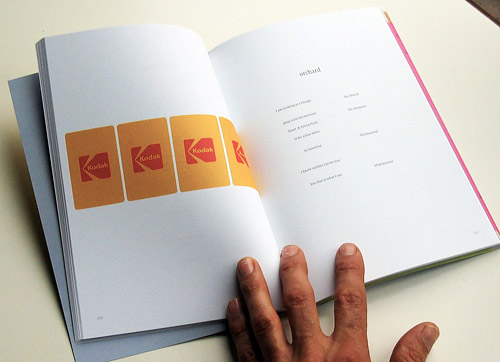
18
O’Mara’s subtext begins with an epigraph from Wittgenstein: “What is not expressed by a symbol is shown by its application” (1). I dwelled for a long time on this statement, thinking about the word ‘application’ and its relationship to symbolism. Application is the action of setting in motion, of ‘bringing to bear,’ of spreading. It can refer to a set of uses or to a range of potentials. It is in and of process. To express, on the other hand, is to draw out, or squeeze. So perhaps, in thinking about symbolic meaning, we might say that what is not drawn out, by force or by habit, can be shown when put into motion. For example, we might be tempted to squeeze a psychological symbolism from a childhood photograph, or we might let the image wander into different territories of meaning–like the compositional or tonal qualities of black and white. The application of a symbol, here, refers to its potential to move and be moved.
19
In an artist’s statement for the Australian anthology, The Material Poem, O’Mara says of his work: “any ordinariness found in the written/visual context is exactly that” (122). Like Jones–and like Wittgenstein–O’Mara is attentive to the fine complexities of ordinary language use. O’Mara’s poetics is the accretion of words and images as they emerge from the everyday. The finished works, describes O’Mara, might be “incidental hypothesis, cloned typeset function, absurdist declarations or single word theory” (122).
20
subtext begins with a one-line poem, alone in the centre of the page: “i am exactly happy” (2). Exactness is key here: the poem is exactly, perfectly formatted and typeset so that the otherwise empty page becomes a major compositional element of the poem. The broad, matte stretch of paper and the delicate glyphs of text combine, exactly, happily. In the same way that O’Mara’s visual poems interrogate boundaries of image and text, the entire collection interrogates boundaries of page and poem.
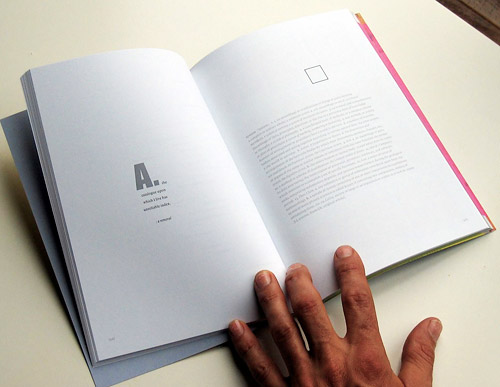
21
Squares and rectangles dominate the aesthetic of this collection. There is, of course, the page. Then there are written poems in single-stanza structures (squares and rectangles). There are visual poems, in which language fills a rectangular space with a pattern. Images and photographs are crisp-edged and angular. Throughout many of the works, there are empty boxes, finely outlined, punctuating short lines of texts.
22
In one work, a small, grey rectangle, formatted to the right-hand-side of the page, sits above a poem: “a man & his wife / having whitegoods / in the kitchen” (11). In another, a large square comprised of 25 smaller black-outlined squares, is accompanied by the text “1(a). the nature of subdivisions” (23). The text nudges just to the right of top edge of the square as though it were the title of a graph or diagram.
23
Photographs appear on many of the poem-pages. There is a family shot of two small boys in matching outfits, each looking distractedly out into a backyard. To the left, mimicking the shape of the photo, a block of text is composed using the repeated line “brothermebrothermebrother” (5). These two boys recur throughout the poems, along with two small girls. At the end of subtext, O’Mara notes that his father took all the family shots. That the images are O’Mara and his siblings is interesting, beyond a simple biographical fascination. It is interesting because the other images–both textual and visual–seem to be either found-objects or formal experiments. By contrast, the black-and-white photographs bring a sense of historical and temporal complexity. Yet I am careful not to linger on this sense as I read, remembering Wittgenstein’s epigraph, and remembering what O’Mara has said of his compositional practice in The Material Poem:
24
Sometimes, I impose an isolated declaration upon my work somewhere between deconstruction & retrieval, but that is merely a customised sound grab. No, they feel as they appear, to me that is, an immersion into the poetic & visual possibility of the word, perhaps life itself, just simply what I make. (122)
25
It is difficult to talk about O’Mara’s work in a way that feels sufficient for its scope. Each poem is at once acute and diffuse. Some of his language has the localised impact of a small blade: “apologies on mobile phones. yiddish word 4 intolerance. / pulling my dry tonsils. building nation. self burial”, (7) and some has the loose, moving quality of water:
26
5 4 3 2 1 a
...
like white lungs
the plum tree flowers
and unhindered
I would not exist.
this chronic sky. (9)
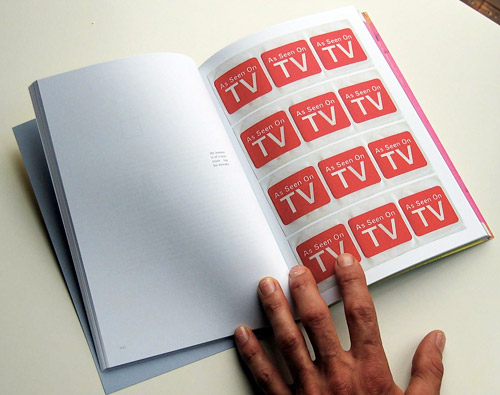
27
There is also a great deal of humour. Repeated colour images (in primary reds, blues and yellows) of daily banalities–“CORNER-CUT / TOPSIDE” (30), presumably from a butcher’s window, and “AS SEEN ON / TV” (47), a collection of identical stickers, perhaps waiting to be put on a coffee percolator or exercise bike–are perversely attractive. In a long, unnamed text-poem, O’Mara imagines an absurd metropolis of the future: a techno-utopian city ruled by the milk crate. The language assumes the tone of a committed, big-vision autocrat: “a revelatory vocabulary will need to be developed. including / a national prayer. I have begun to develop a basic tune, appropriating some household words / & other brand names” (50). The poem ends with a final blade-twist and a final laugh:
28
finally, all copyright will remain with the ruling state.
any human experience ethical concept or new arrival is ultimately futile. the
individual will always be consumed. as for sex, a problem remains with the nipple. (51)
29
American vispo artist Geof Huth has said in an interview with Ron Silliman and Crag Hill (willtoexchange.blogspot.com) that
30
A visual poem requires evaluation from a number of perspectives at once. If I were to design a structure to signify the defining characteristics of a visual poem, it would be similar to a mixing board and include at least three input channels working in concert with and in opposition to each other.
31
Huth goes on to describe the three channels (knobs that can be twiddled up or down accordingly): the visual aspect of the poem, the verbal aspect of the poem, and the “degree of integration of the visual and the verbal.” Elsewhere, Huth describes this integration of the visual and verbal as the meeting of salt- and freshwater at the mouth of a river. “You never know if you are swimming in the river or an ocean. All you know is that the water is brackish” (dpqb.blogspot.com).
32
At times in subtext, this verbal/visual brackishness is literally an image-word relationship. One work, for example, has two forest-green squares, captioned with the poem “Hansel & Gretel / become consumers” (33). At other times, it is a meditation on the pictorial genealogy of etymology: “[NL. from GK typho(s) type + graphia writing]” (31). Elsewhere, it is a perfect verbal image: “a minimal grid of fluorescent light” (26). If we simultaneously imagine the mixing board and its three channels and the anarchic ambiguity of brackish water, then we have an idea of the different modes at play, productively and paradoxically, in this collection.
¶
The relationship between the two halves of How To Do Words With Things is interesting. Of course, they have a lot in common. They are both ‘poethical’–Retallack’s term for a poetics committed to the continuous creation of “an ethos of the way in which events are understood” (The Poethical Wager, 9). They are both highly critical of consumer capitalism and its “cultural pathologies” (Jones, 38). Both are attuned to the small-scale and the local, concerned with the material experiences of everyday experience. Both are experimental in the sense of a willingness to attempt and to trial.
33
Their differences are harder to articulate. Reading Jones’s manifesto is an intensely stimulating experience, whereas reading O’Mara is almost disorienting. If in Jones’s half the energy builds towards a focal point, then O’Mara’s half refracts its energy so that every word and every image is a focal point. Read together, How to Do Words With Things has the kind of fundamental order-disorder dynamic of a life-giving chaotic system.

Astrid Lorange
Astrid Lorange is a PhD candidate, researching the poetics of Gertrude Stein and Joan Retallack, and the relationship between the two women and philosophies of twentieth-century sciences. This year she is co-directing the Critical Animals creative research symposium at This Is Not Art in Newcastle.